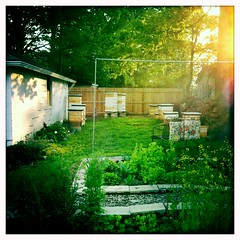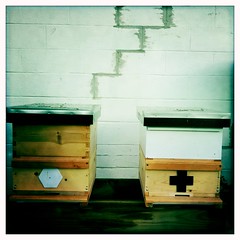 In under two months, the number of hives in our backyard has more than quadrupled. From 3 to 13 hives in five weeks...whew. It is a lot of hives to host in town, and really, once they are full grown, it will be too much and we'll have to move several of them to other locations.
In under two months, the number of hives in our backyard has more than quadrupled. From 3 to 13 hives in five weeks...whew. It is a lot of hives to host in town, and really, once they are full grown, it will be too much and we'll have to move several of them to other locations. In the short term, the populations are low and we like the convenience for monitoring their progress. We've expanded in three different ways this year: bought packages, caught swarms, and made splits. All of these methods begin humbly with small populations of bees trying to build up a new colony. Specifically, these bees must first draw the wax into the honeycomb form they use for storing food and raising brood*. For packages, where you introduce a population of bees to a foreign queen, it is particularly important to be able to monitor whether or not the queen has been accepted by the workers.
In the short term, the populations are low and we like the convenience for monitoring their progress. We've expanded in three different ways this year: bought packages, caught swarms, and made splits. All of these methods begin humbly with small populations of bees trying to build up a new colony. Specifically, these bees must first draw the wax into the honeycomb form they use for storing food and raising brood*. For packages, where you introduce a population of bees to a foreign queen, it is particularly important to be able to monitor whether or not the queen has been accepted by the workers.So while the populations are small and somewhat "needy" (note that we say this strictly from a management perspective), it is ok to keep 13 in a city plot. But that's why we've started calling our
 |
| three new hives |
But one potential problem of this high density approach is the bees' ability to distinguish their hive from the others. Bees have quite a sophisticated sense of navigation, but it is also unusual in a natural setting for so many similar looking hives to be in such close proximity. Because they recognize colors and shapes, one technique to help them find their home is to tack different shapes above each hive's entrance. I won't lie, it also
 |
| branding helps us feel special |
Now, the little 5 branding...that's strictly for us :)
*Wax is secreted by glands on the underside of a honeybee's abdomen. But it requires a lot of energy. For every 1lb of wax secreted, it takes approximately 6 lbs of honey.

No comments:
Post a Comment